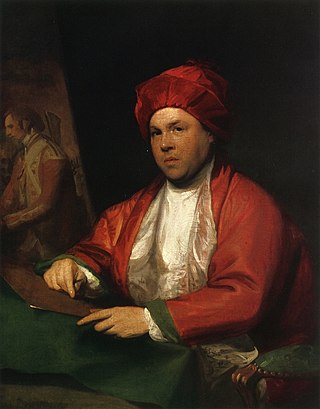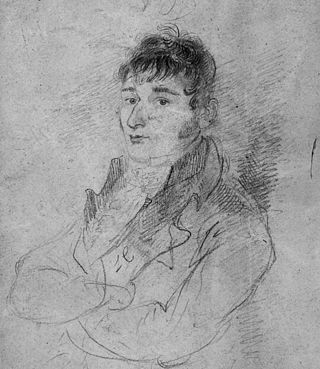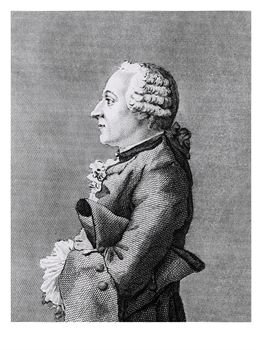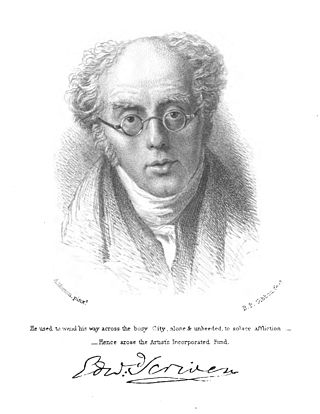
John Anderson (born 1775) was a Scottish wood-engraver and illustrator, a pupil of the British wood-engraver Thomas Bewick.

John Anderson (born 1775) was a Scottish wood-engraver and illustrator, a pupil of the British wood-engraver Thomas Bewick.
Anderson was born at Foveran in Scotland in 1775, the son of James Anderson of Hermiston. He was a pupil of Thomas Bewick, taken on at his father's wish to help with illustration of a periodical, The Bee. The relationship with Bewick ended acrimoniously, however, and by the later 1790s he was working for London printers. He went abroad by 1805, and died by 1808. [1]
Anderson cut (after drawings by George Samuel) [1] the blocks which illustrate Grove Hill, a 1799 poem by Thomas Maurice. [2] It was sumptuously issued by Thomas Bensley in 1799, in a book that has been compared with William Somervile's The Chace. Anderson, with Shakespeare's Walk in the book, almost equals Bewick, according to Ernest Radford writing in the Dictionary of National Biography , and his treatment of foliage is reminiscent of the prints in Robert Bloomfield's Farmer's Boy, where the first edition of 1800 notes "with ornaments engraved by Anderson." These wood-engravings have been erroneously ascribed to Bewick. [3]
Anderson also engraved illustrations to an edition of Junius. Redgrave says he formed "a style of his own and showed much ability". [3]
Anderson engraved an 1841 edition of Gilbert White's Natural History of Selborne . [4]

Thomas Bewick was an English wood-engraver and natural history author. Early in his career he took on all kinds of work such as engraving cutlery, making the wood blocks for advertisements, and illustrating children's books. He gradually turned to illustrating, writing and publishing his own books, gaining an adult audience for the fine illustrations in A History of Quadrupeds.

Wood engraving is a printmaking technique, in which an artist works an image into a block of wood. Functionally a variety of woodcut, it uses relief printing, where the artist applies ink to the face of the block and prints using relatively low pressure. By contrast, ordinary engraving, like etching, uses a metal plate for the matrix, and is printed by the intaglio method, where the ink fills the valleys, the removed areas. As a result, the blocks for wood engravings deteriorate less quickly than the copper plates of engravings, and have a distinctive white-on-black character.

William Woollett was an English engraver operating in the 18th century.

Dr Alexander Anderson was an American physician and illustrator.

Henry Thomas Ryall was an English line, stipple and mixed-method engraver and later used mixed mezzotint.

William Harvey was a British wood-engraver and illustrator.

Luke Clennell was a British wood-engraver and painter.

Charlton Nesbit was a British wood-engraver.
Allen Robert Branston (1778–1827) known more generally as Robert Branston, was a British wood-engraver.
Thomas Kerr Fairless was an English landscape-painter.

John Swaine, was an English draughtsman and engraver.

Edward Scriven was an English engraver of portraits, in the stipple and chalk manner. Scriven was the pre-eminent engraver of his generation, with 210 portraits ascribed to him by the National Portrait Gallery.
Francis Engleheart (1775–1849) was an English engraver.
Isaac Taylor (1730–1807) was an English engraver.
Robert Scott was a Scottish engraver.
Jane Bewick (1787–1881) was the eldest daughter of Isabella and wood-engraver Thomas Bewick. She edited her father's biography and supervised his works. She and her sister Isabella Bewick agreed that the Bewick engravings, blocks and papers should be donated to institutions including the British Museum.

A History of British Birds is a natural history book by Thomas Bewick, published in two volumes. Volume 1, Land Birds, appeared in 1797. Volume 2, Water Birds, appeared in 1804. A supplement was published in 1821. The text in Land Birds was written by Ralph Beilby, while Bewick took over the text for the second volume. The book is admired mainly for the beauty and clarity of Bewick's wood-engravings, which are widely considered his finest work, and among the finest in that medium.

John Thompson was a British wood-engraver. He is best known for his contribution to William Yarrell's 1843 History of British Birds. He was described as the most distinguished wood-engraver of his time.
Robert Johnson was a British artist, an apprentice of Thomas Bewick in his Newcastle upon Tyne workshop. Bewick taught him wood-engraving, but discovered Johnson's talent for sketching in watercolour directly from nature.
Samuel Williams was a British draughtsman and wood-engraver.